Toshiba X305-Q725: Quad-Core Gaming Notebook
by Jarred Walton on March 11, 2009 1:00 AM EST- Posted in
- Laptops
Gaming Performance
We've chosen to focus on "reasonable" settings for the games below. That means we run Assassin's Creed and Company of Heroes in DX9 mode at maximum detail setting - DX10 reduces performance by quite a bit in AC and by a much larger amount in CoH. We run Crysis at Medium settings (for reference, High detail drops performance almost in half: 18.3FPS). The remaining games are at maximum detail settings, but without any anti-aliasing. Some titles can certainly handle higher detail settings - Fallout 3 for instance will work fine at up to 1920x1200 0xAA and maximum detail, and the same holds for other games - however, we chose to focus on 1680x1050 performance because of the X305 LCD and because that resolution offers more consistently playable performance on gaming laptops.
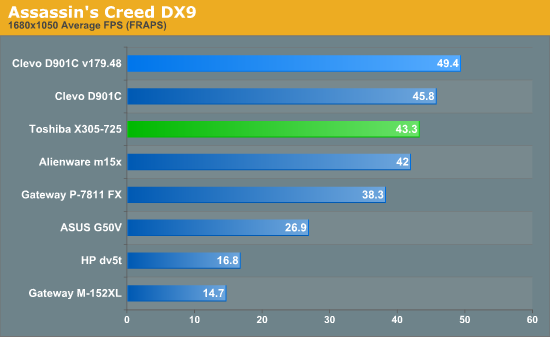
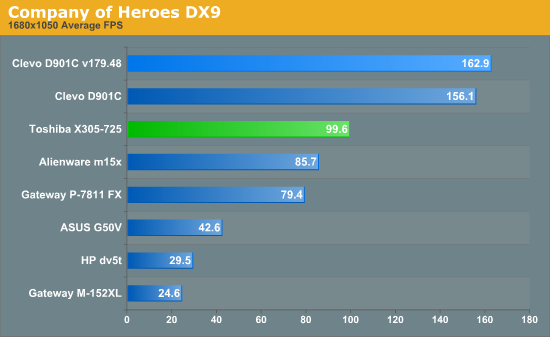
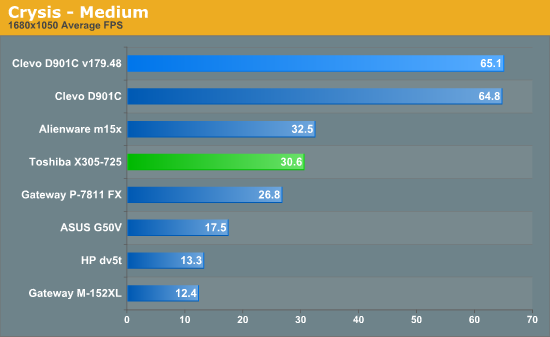
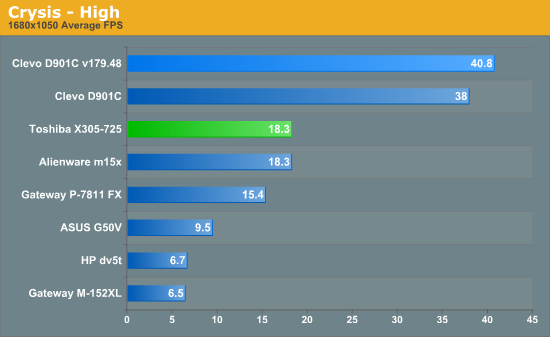
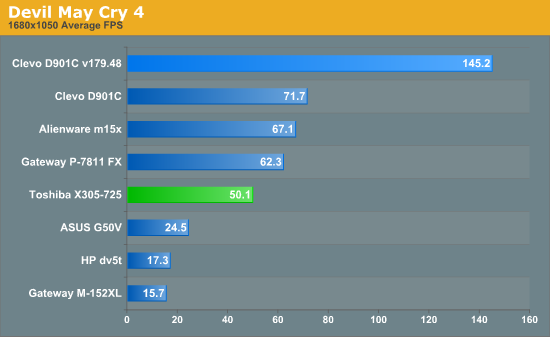
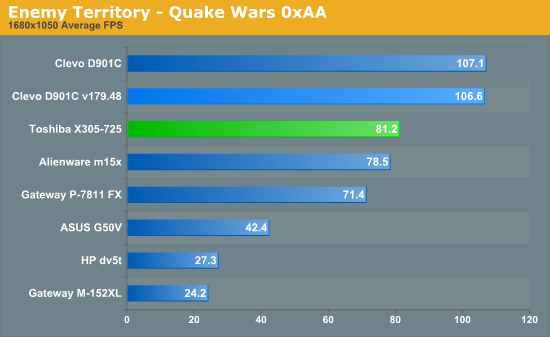

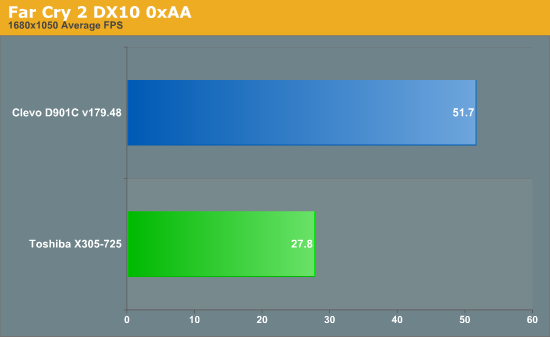
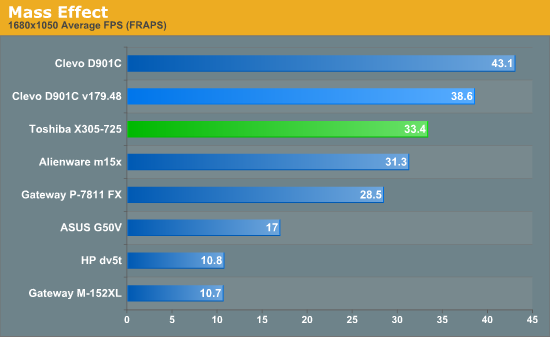
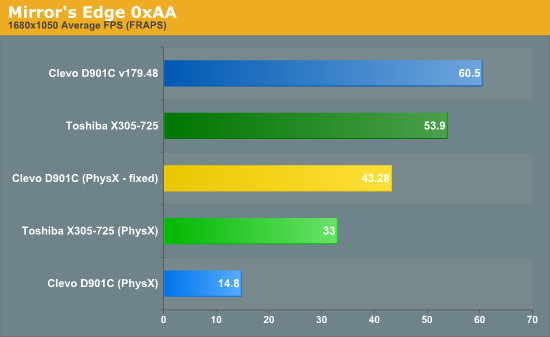
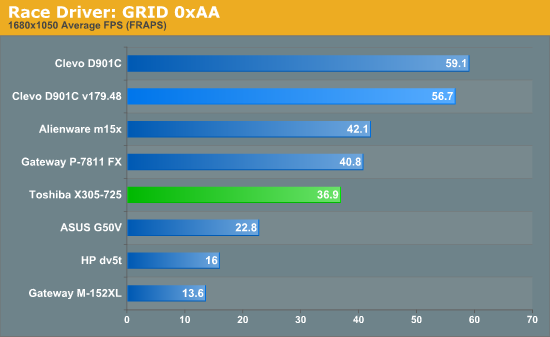
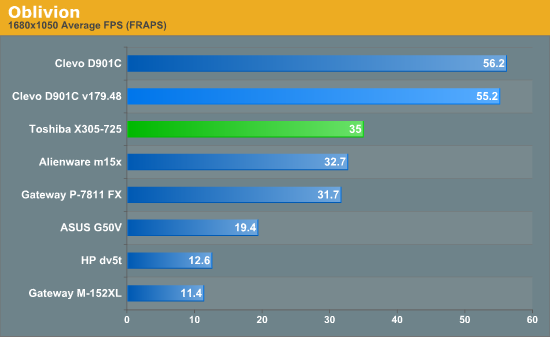
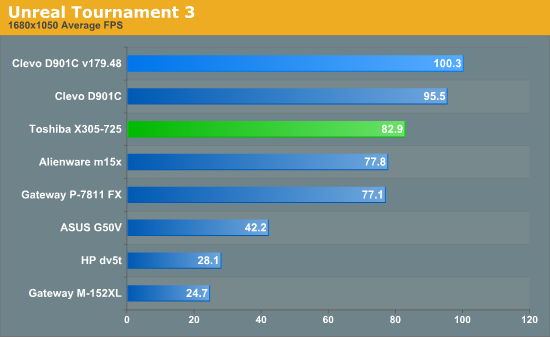
We do run into several situations where the detail settings create system bottlenecks, but overall the SLI 8800M GTX configuration in the Clevo laptop is clearly superior to a single 9800M GTX.
Assassin's Creed likes CPU performance almost as much as GPU power, so the lower clock speed of the Q9000 definitely has an impact here. DX10 performance is acceptable as well and helps to reduce the CPU clock speed penalty, but the overall look of the game isn't substantially changed and performance is still better in all cases under DX9. Enemy Territory: Quake Wars, Fallout 3, Mass Effect, Mirror's Edge, and Unreal Tournament 3 are all in a similar situation. The GPU advantage of the D901C does allow 1920x1200 game play in all of these titles and should increase the margin of victory, but most of these titles are hitting other bottlenecks.
Company of Heroes, Crysis, Devil May Cry 4, Far Cry 2, Oblivion, and GRID all show a greater than 50% performance advantage to the Clevo D901C notebook relative to the X305-Q725. Again, keep in mind that these two notebooks are priced quite similarly, so if you're after raw performance and don't mind a slightly heavier (and perhaps less attractive) chassis the D901C is the clear winner. The dual-core 3.0GHz CPU is a much better choice right now in gaming, though you could install up to a Q9550 if you prefer quad-core processors for non-gaming purposes.
Of all the games we tested, only one title shows any advantage to the 9800M GTX over the 8800M GTX SLI: Mirror's Edge. The advantage is further limited to situations where PhysX support is enabled; otherwise the 8800M SLI is slightly faster. We have not yet confirmed with NVIDIA whether this is a driver bug or is caused by a lack of appropriate hardware on the 8800M GPUs, but we would assume it's a driver issue. The PhysX effects do look nice at times, but even the X305 hits plenty of situations where performance can drop dramatically, and we'd recommend leaving PhysX disabled on these laptop GPUs.
Update: We discussed the Mirror's Edge PhysX issue with NVIDIA and they recommended a manual install of the PhysX drivers just to ensure they were working properly. It looks like the unified graphics/PhysX driver failed to work properly, although the system seemed to think the drivers installed properly. We uninstalled PhysX, rebooted, and installed the drivers again, and that cleared up the performance issue. As you can see, the performance of the D901C is now where you would expect, coming in 33% faster than the X305-Q725.
In the past, we've been hesitant to strongly recommend any laptops with dual GPUs, simply because the drivers were not updated frequently enough to make that a viable solution for long-term gaming pleasure. NVIDIA has now addressed the major stumbling block for SLI in a laptop, so for the mobile gamers we would definitely recommend an SLI notebook over the X305-Q725. In a best case scenario, dual GTX 280M GPUs (with the appropriate CPU) should end up providing around 50% more performance than the 8800M GTX SLI represented by the Clevo D901C, and potentially more than twice the performance of the single 9800M GTX in the X305-Q725.
Before you get too excited about the potential for mobile gaming, we do need to give a few words of caution about relative performance. The GTX 280M may be the fastest current gaming solution for notebooks, but at its core the GTX 280M is nothing more than a mobile version of the GeForce 9800 GTX. The desktop GTX 280/285 (and Radeon HD 4870) are well out of reach of anything a laptop can achieve and should remains so for some time. Short of external cards that connect via ExpressCard adapters, gamers looking for maximum performance will want to play on a desktop, and ExpressCard adapters are hardly a panacea - is anyone really going to get a laptop only to add a secondary device that requires a separate power source? I can't say the prospect is very appealing to me at any rate.










32 Comments
View All Comments
Morelian - Wednesday, March 11, 2009 - link
I've had 2 of the Gateway FX series of notebooks, the first one was the 3mb Vista 32 version with a slower dual core, but it seemed to run games "ok"-WoW, TF2, AoC. Sadly the monitor got stepped on, so now this one is beside the TV functioning as the home media server and does a fine job of that. The first Gateway cost around 1300, then last one was 1050 but they are going for 1150 in Bestbuy now. The newer Gateway has the 2.6 mhz cpu, 4 gb ddr3 and a nicer screen and I find it handles whatever games I throw at it reasonably well. Battery life is about 2 hours, and the large keyboard lets you get work done efficiently.I think I'll wait until Gateway comes out with their quadcore system, both of mine have been really stable, offer nice performance, and aside from the size and weight of the 17 form factor I can't really knock them.
JarredWalton - Wednesday, March 11, 2009 - link
The Gateway FX P-7808u is now shipping, though the price is higher than the last FX "mainstream" model at around $1700 right now. You can http://www.jr.com/gateway/pe/GTW_P7808U/">buy it here if you're interested, or wait another week or two for my review. Short summary looking at the specs is that they've upgraded the CPU substantially (Q9000), but the LCD is back to the 1440x900 of the P-6831. That does make gaming at the native resolution more viable with the single 9800M GTS, though.Pessimism - Wednesday, March 11, 2009 - link
I stopped reading as soon as I read NVIDIA. Three years of defective GPUs that disintegrate under heat and a manufacturer chooses them for a high performance (high temperature) premium gaming notebook.Exar3342 - Wednesday, March 11, 2009 - link
The instability of the machine seems a very big issue to me. I definitely wouldn't spend $2000+ on a machine that hard boots when you try playing a number of different games! Considering that is what this designed for (mobile gaming) that is a serious issue for me and would definitely make this a "non-buy".jabber - Wednesday, March 11, 2009 - link
Cant help but think what $2000 of desktop PC components would give me rather then this....thing?I've known several folks that have bought such monster laptops and all have regretted it later.
Filed under "Seemed like a good idea at the time!"
Dakkota - Sunday, March 15, 2009 - link
These type of computers are made for people like me, I travel the world for work and have been a gamer since the 70's and pong. I don't own this particular one, I have a Clevo M571TU, ( can be bought as SagerNotebook.com and some others) but I was looking to see what the competition has, if you go to the Clevo site, you'll see what awesome machines these are. Yes, the brick and all the that stuff travel around with me, and I play games like Crysis, Far Cry, Fear 2, WOW, all sorts, these machines are great. This is my second Clevo I'm on now, after 3 years with the old one, I wanted to update the technology, people in my family were clamoring to get the old one, these are very stought machines, yes, costly, especially completely decked out like I get them, but worth every penny for the gaming road warrior, and believe me, I've met quite a few.Nfarce - Wednesday, March 11, 2009 - link
Uhm, yeah, that would be me. My $1,800 Dell E1705 Inspiron went from being a pretty decent portable DX8/9 gaming system and DVD movie player in 2006 to basically a websurfer today that sits in the living room next to the remote for when I want to surf and watch TV simultaneously. Damn if only I could have that money back - playing HL2 and other games while traveling for work (that I already played at home on a real gaming bo anyway). It just wasn't worth it in the long run. But I was happy in the beginning - sounds like all my former relationships too, LOL.GaryJohnson - Wednesday, March 11, 2009 - link
I think a lot of people who want portable gaming PCs would be better served with SFF desktops.crimson117 - Friday, March 13, 2009 - link
And little portable LCD monitors?JarredWalton - Friday, March 13, 2009 - link
I guess I look at it this way. For a gaming notebook you need to take the following if you want to play games on the road:1) Notebook
2) Power brick
3) Mouse
For an SFF, you need:
1) Main SFF box (plus cords)
2) LCD display (plus cords)
3) Mouse
4) Keyboard
5) Headphones
Now, I won't dispute that an SFF (well, uATX system - SFFs have their own set of problems) is a more cost-effective solution for gaming, offers better performance, and is expandable. However, it is a far cry from being transportable like a DTR setup. Throw in the fact that many proprietary SFFs are not particularly cheap (Shuttle) and quality control on those same SFFs is poor in my experience, and I'd say if you really want to game on the road the DTR market is worth a serious look. You still might go with an SFF, but only if you don't actually travel+game all that much.